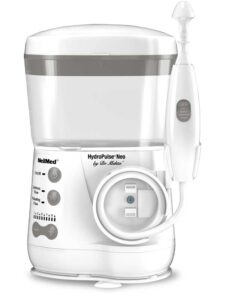Empty Nose Treatment
Empty-Nose Syndrome (ENS)
Dr. Eugene Kern of Mayo Clinic first coined the term “empty-nose syndrome.” He applied it to the persons complaining of pain and burning in the nose, a sensation of “can’t breathe” through the nose, recurrent infection, heavy crusting, and sometimes depression. It is often seen when too much turbinate material has been removed. This was further described in the Los Angeles Times article by Aaron Zittner on May 10, 2001. He interviewed persons who complained of these symptoms. Many persons do develop depression because of constant symptoms and sensation of not getting enough air.
Do I have empty-nose syndrome?
After surgery, some persons find that they have crusts and a constant feeling that they are not getting enough air. This can occur when too much nasal structure is removed during surgery. Here, the turbinates no longer function to warm and moisten the air. The nasal opening may be too wide. It’s like a garden hose—when it is wide open, it can’t reach the flowers nine feet away. Pulsatile irrigation, as a substitution for absent cilia function, often helps these symptoms. Breathe-ease XL Nasal Moisturizer Gel acts to bring moisture to the nasal membranes. Patients may have considerable emotional problems because for twenty-four hours a day, they feel like they are not getting enough air. These persons are even more sensitive to irritation from benzalkonium.
There are three sets of turbinates, or shelves, on the sides of the nose. These provide moisture, warmth, and direct airflow. Sometimes, these are lost to disease. They shrivel and no longer function to moisten and warm the air. Sometimes, they are removed by surgery. There are articles in journals recommending removal in order to provide adequate opening for breathing. When the turbinates are enlarged and block the breathing, removing them does open the airway; but it is important to leave the nasal mucosa intact. In ENS, there is dryness, burning, crusting, and sometimes pain. The pain may come from the raw surface or the exposure of nerve endings or infection.
Once the turbinates can no longer provide mucus, cilia, and enzymes to protect against infection, then secondary infections occur regularly, and the patient may require additional surgery to clear the infection. Often these are the persons who have had three or four subsequent surgeries. They are repeatedly on antibiotics. too.
Current treatment consists of pulsatile irrigation twice a day and a moisturizer gel twice a day. Various surgical procedures are being done. Dr. Steven Houser of Cleveland is using procedures to build up the sides of the nasal walls. (See http://www.geocities.com/shouser144/ for his latest news.) His original approach to solving this problem is not just to make the nose narrower but also to direct the flow of air in order to reduce the symptoms. Currently various biological materials are used as implants to narrow the airway and improve air flow.
The worst symptom, in my opinion, is the feeling of not getting enough air. The nose acts like a pressure valve, like the control on the water hose. Pinch the opening of the hose and the stream sprays far. Open the hose wide, and the water dribbles at your feet. So the patient is missing the correct pressure and flow of air and feels he isn’t able to breathe adequately.
All this can lead to depression. After all, you breathe twenty-four hours a day. With an upset stomach or broken finger, the pain is limited. With asthma, no matter how severe, there is relief with medication and oxygen. With ENS, you always have this feeling.
In sinus surgery it is often necessary to move—or even remove—the middle turbinate, but this doesn’t cause ENS if the inferior turbinates remain intact.
Since there is considerably less resistance to infection, it is common to add Xylitol to the Hydro Pulse Saline irrigation. If you add two teaspoons of Xylitol to the 500 cc basin you get a one percent Xylitol solution. This makes it difficult for bacteria to remain in the nose/sinuses.

